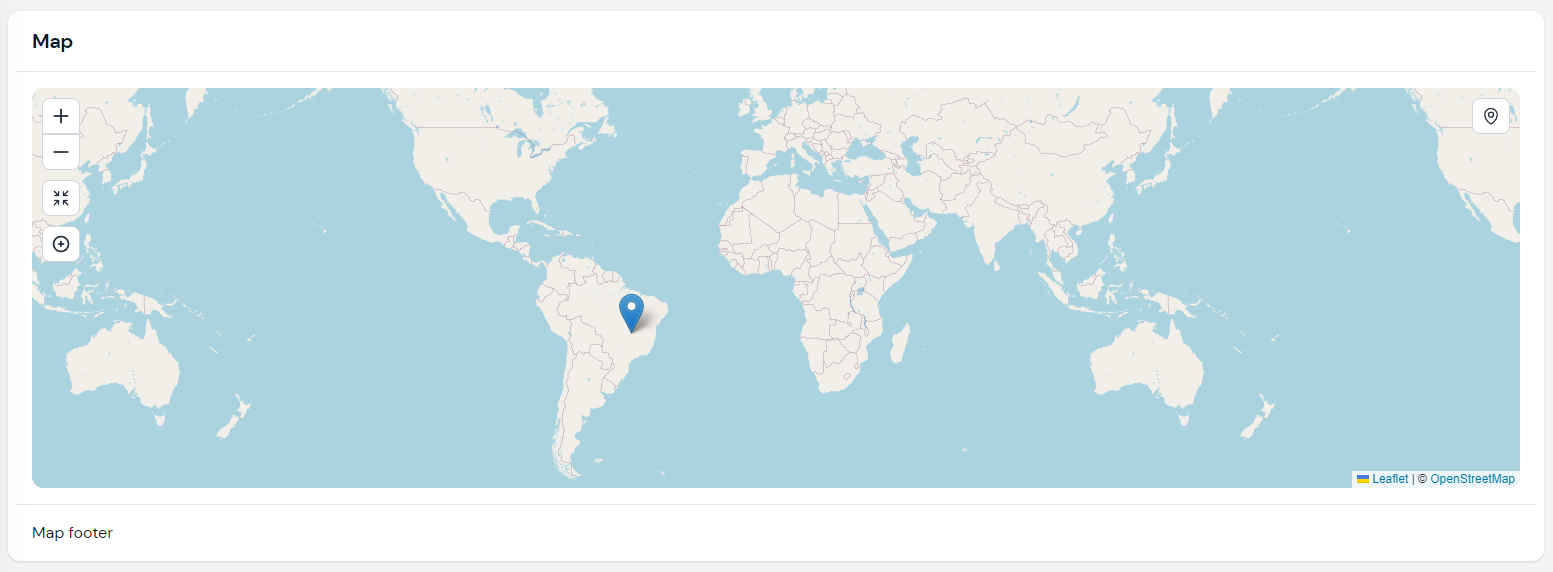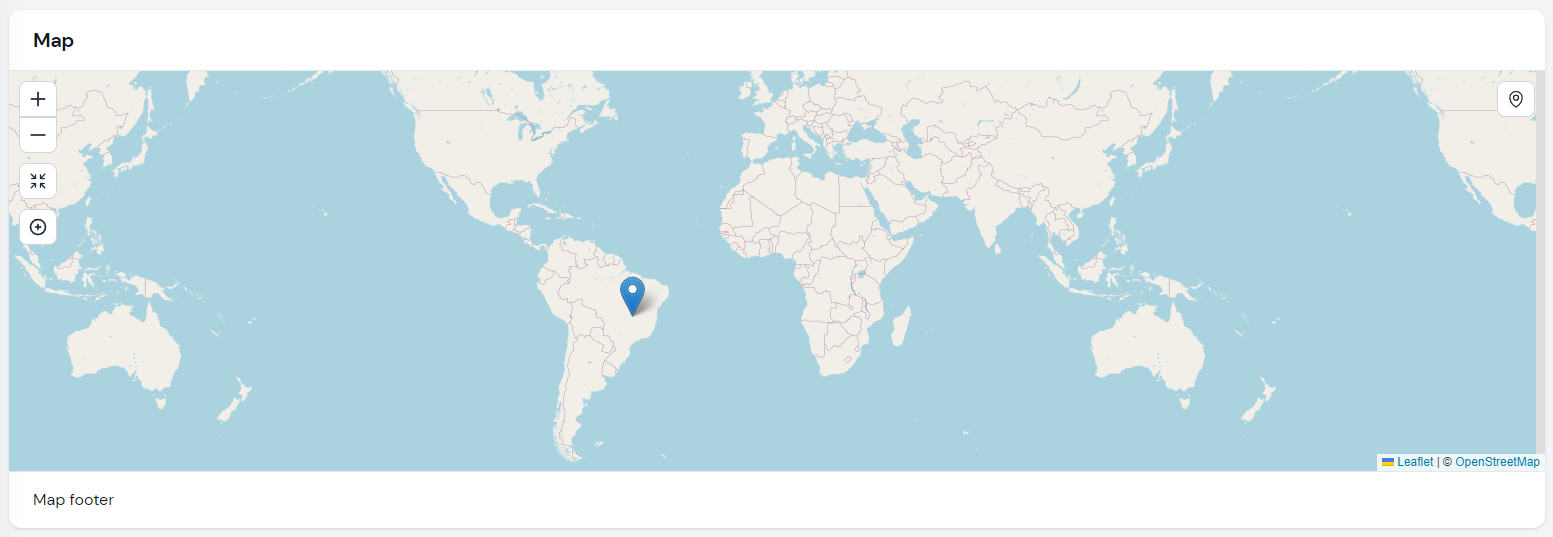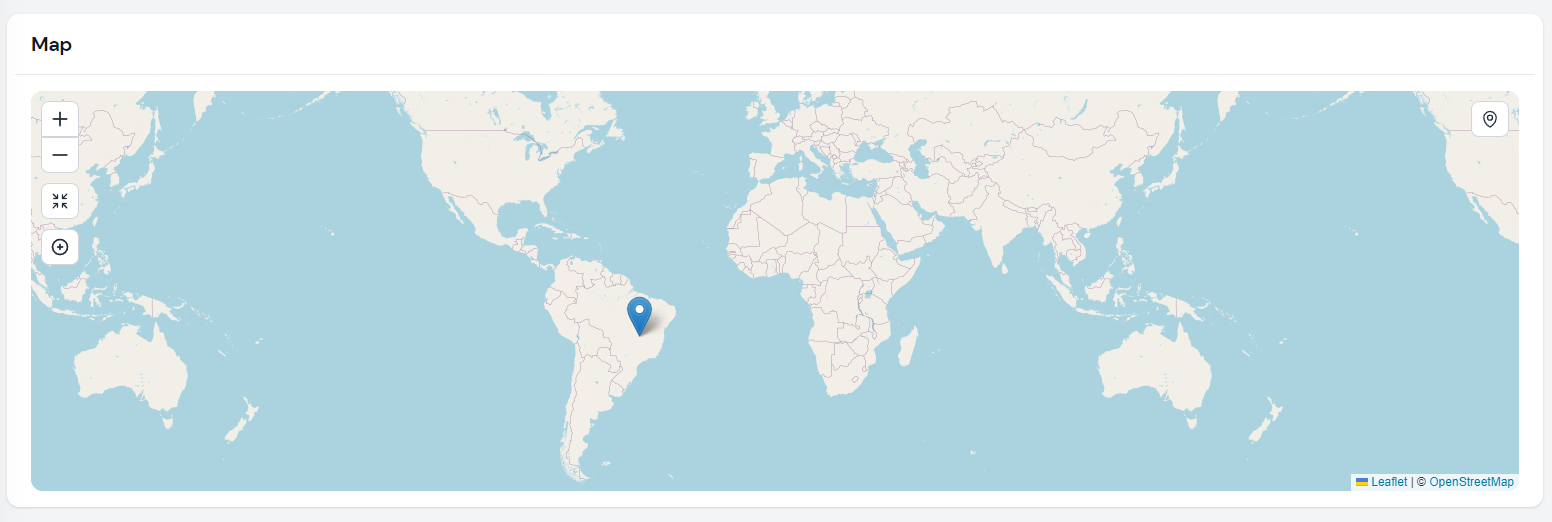- Installation
- Usage
- Map Configuration
- Tile Layers
- Actions
- Markers
- Polylines
- Polygones
- Rectangles
- Circles
- Images
- Credits

Render map widgets using Leaflet.
- Support for multiple maps on the same page
- Built-in actions:
CenterMapAction,ZoomAction,FullpageActionand ,FullscreenAction - Add Filament Actions directly on the as map control buttons
- Multiple layers support. A DarkModeTile layer is included.
- Marker clustering support
Note For Filament 2.x use 2.x branch
#Installation
composer require webbingbrasil/filament-maps#Usage
Create a widget class and extend Webbingbrasil\FilamentMaps\Widgets\MapWidget:
use Webbingbrasil\FilamentMaps\Actions;use Webbingbrasil\FilamentMaps\Marker;use Webbingbrasil\FilamentMaps\Widgets\MapWidget; class Map extends MapWidget{ protected int | string | array $columnSpan = 2; protected bool $hasBorder = false; public function getMarkers(): array { return [ Marker::make('pos2')->lat(-15.7942)->lng(-47.8822)->popup('Hello Brasilia!'), ]; } public function getActions(): array { return [ Actions\ZoomAction::make(), Actions\CenterMapAction::make()->zoom(2), ]; }}If you create a new widget using the
make:filament-widgetcommand, remember to remove the view created along with it otherwise the map will not be rendered.
#Map Configuration
For some configuration its possible to use properties:
-
$mapOptions: array with options available on Leaftlet. See Leaflet documentation for more details. -
$tileLayerUrl: string or array with tile layer url`s. Default to OpenStreetMap. -
$hasBorder: show a border around the map. Default istrue. -
$rounded: show a rounded border around the map. Default istrue. -
$height: height of the map. Default is400px. -
$heading: set the heading of the map. -
$footer: set the footer of the map. -
$fullpage: show the map in fullpage mode. Default isfalse.
But you can also use the setUp method if you need more control:
public function setUp(): void{ $this ->tileLayerUrl(...) ->height(..) ->rounded(..) ->mapOptions(..) ->mapMarkers([ ... ]) ->fitBounds([ [lat, lng], [lat, lng] ... ]) ->actions([ .. ]);}The
setUpmethod is called onmountof the widget. See livewire lifecycle hooks for more information.
#Tile Layers
The map uses OpenStreetMap tiles by default, but you can change it to use any other provider using $tileLayerUrl property or tileLayerUrl method. It's recommended to also use the tileLayerOptions to set correct attributions.
#Multiple Tile Layers
You can also use multiple tile layers:
protected string | array $tileLayerUrl = [ 'OpenStreetMap' => 'https://{s}.tile.openstreetmap.org/{z}/{x}/{y}.png', 'OpenTopoMap' => 'https://{s}.tile.opentopomap.org/{z}/{x}/{y}.png']; protected array $tileLayerOptions = [ 'OpenStreetMap' => [ 'attribution' => 'Map data © <a href="https://openstreetmap.org">OpenStreetMap</a> contributors', ], 'OpenTopoMap' => [ 'attribution' => 'Map data © <a href="https://openstreetmap.org">OpenStreetMap</a> contributors, SRTM | Map style © <a href="https://opentopomap.org">OpenTopoMap</a> (<a href="https://creativecommons.org/licenses/by-sa/3.0/">CC-BY-SA</a>)', ],];And you can use a action to change the tile layer:
Actions\Action::make('mode') ->icon('filamentmapsicon-o-square-3-stack-3d') ->callback('setTileLayer(mode === "OpenStreetMap" ? "OpenTopoMap" : "OpenStreetMap")'),#Dark Mode
If you want to use a dark mode tile layer, you can use the HasDarkModeTiles trait. This trait will automatically set two tiles layers and listen Filament dark-mode-toggled event. You can change the default tile layers using the $lightModeTileLayerUrl and $darkModeTileLayerUrl properties.
#Actions
You can add actions to the map widget. Actions are buttons that can be clicked to perform an action using a JS callback. You can create your own actions or use the ones provided by the package.
#Zoom Action
The ZoomAction action will add a button to the map that will zoom in or out the map. You can set the zoom level using the zoom() method:
use Webbingbrasil\FilamentMaps\Actions;Actions\ZoomAction::make()->zoom(2), // Zoom in/out 2 levels#Center Map Action
This action will center the map on a specific position.
use Webbingbrasil\FilamentMaps\Actions; public function getActions(): array{ return [ Actions\CenterMapAction::make()->centerTo([51.505, -0.09])->zoom(13), ];}You can also center the map on user position:
Actions\CenterMapAction::make()->centerOnUserPosition()->zoom(13)Note: The center on user position feature will only work if the user browser supports Navigator.geolocation. Also, the user must be on a secure context (HTTPS) and needs to allow access to the location.
#Fit Bounds
You can use fitBounds() to adjusts the zoom level and center of the map to show a given geographical area
Actions\CenterMapAction::make()->fitBounds([ [lat, lng], [lat, lng],])You can pass multiple points to be used in fitBounds or use the initial bounderies configured in setUp()
public function setUp(): void{ $this->fitBounds([ [lat, lng], [lat, lng], ... ]);} public function getActions(): array{ return [ CenterMapAction::make()->fitBounds($this->getFitBounds()), ];}#Full Page or Full Screen Action
You can add a button to the map to show it in full page or full screen mode.:
use Webbingbrasil\FilamentMaps\Actions;Actions\FullpageAction::make()Actions\FullscreenAction::make()#Custom Action
You can create your own actions using Webbingbrasil\FilamentMaps\Actions\Action.
For example, a action to add new markers:
use Webbingbrasil\FilamentMaps\Actions; Actions\Action::make('form') ->icon('filamentmapsicon-o-arrows-pointing-in') ->form([ Forms\Components\TextInput::make('name') ->label('Name') ->required(), Forms\Components\TextInput::make('lat') ->label('Latitude') ->required(), Forms\Components\TextInput::make('lng') ->label('Longitude') ->required(), ]) ->action(function (array $data, self $livewire) { $livewire ->addMarker( Marker::make(Str::camel($data['name'])) ->lat($data['lat']) ->lng($data['lng']) ->popup($data['name']) ) ->centerTo(location: [$data['lat'], $data['lng']], zoom: 13) })In this example we use addMarker() method to add a new marker dynamically and centerTo() to set new map center and zoom level.
You can manipulate markers data using:
$liveWire->mapMarkers(array $markers); // update the markers$livewire->addMarker(Marker $marker); // add a new marker$livewire->removeMarker(string $id); // remove a marker$livewire->updateMarker(string $id, Marker $marker); // update a markerNote: Markers need to have a unique name. If you try to add a marker with the same name as an existing one, the existing one will be replaced.
#Using JS
This approach is useful if you want to use a custom javascript to manipulate the map without using Livewire.
Actions\Action::make('center') ->alpineClickHandler(<<<JS map.setView([0,0], 2) JS)Use
mapproperty to access the Leaflet instance on your action handler.
#Action Position
You can set the position of the action using position() method:
$this ->actions([ Actions\CenterMapAction::make()->position('topright'), ])}#Action Icon
You can set the icon of the action using icon() method:
Actions\Action::make()->icon('heroicon-o-home')#Markers
You can add markers to the map widget. Markers are points on the map that can be clicked to open a info popup or execute a JS callback.
use Webbingbrasil\FilamentMaps\Marker; $this ->mapMarkers([ Marker::make('id') ->lat(51.505) ->lng(-0.09) ->popup('I am a popup'), Marker::make('id') ->lat(51.505) ->lng(-0.09) ->tooltip('I am a tooltip') ->callback(<<<JS alert('Hello World!'); JS), ])}The callback method is called during the rendering of the marker and must return a JS that will be executed on event click. Use
mapto access the Leaflet instance in your callback.
#Marker Cluster
You can use the MarkerCluster class to group markers in clusters. This is useful if you have a lot of markers on the map.
use Webbingbrasil\FilamentMaps\MarkerCluster; $this ->mapMarkers([ MarkerCluster::make([ Marker::make('id') ->lat(51.505) ->lng(-0.09) ->popup('I am a popup'), Marker::make('id') ->lat(51.505) ->lng(-0.09) ->tooltip('I am a tooltip') ->callback(<<<JS alert('Hello World!'); JS), ]), ])}#Marker Icon Color
You can set the color of the marker icon using color() method:
Marker::make('id') ->color(Marker::COLOR_RED)See the Marker::COLOR_* constants for all available colors. Default color is Marker::COLOR_BLUE.
#Marker Custom Icon
You can set a custom icon for the marker using icon() method:
Marker::make('id') ->icon( string $iconUrl, string $shadowUrl, array $iconSize, array $iconAnchor, array $popupAnchor, array $shadowSize )You can get extra icons and reledate config from leaflet-color-markers
#Display Marker Details
At the time, markers do not have the same functionality as Actions but using livewire events you can do something similar, for example:
Add a callback to yout marker:
Marker::make('place')->callback('Livewire.emit("updateFooter", ' . $placeId . ')');Register event listener in map widget:
protected $listeners = ['updateFooter' => 'showMarkerData']; public function showMarkerData($placeId){ $place = Place::find($placeId); $this->footer = view('marker-details', $place);}#Polylines
You can add polylines to the map widget. Polylines are lines on the map drawn on the map between two lat/lng points. If your have multiple polylines, each polyline must have an unique name.
public function getPolylines(): array{ return [ Polyline::make('polyline') ->latlngs([ [45.51, -122.68], [37.77, -122.43], [34.04, -118.2] ])->options(['color' => 'blue', 'weight' => 5]) ->tooltip('I am a tooltip') ->popup('I am a popup'), ];}You can use options listed at Leaflet Polyline options
#Polylines actions
You can use actions as described above to manipulate polylines:
Actions\Action::make('add line') ->tooltip('Add line') ->icon('filamentmapsicon-o-map-pin') ->form([ Forms\Components\TextInput::make('name') ->label('Name') ->required(), Forms\Components\Section::make('Start') ->schema([ Forms\Components\TextInput::make('lat1') ->label('Latitude') ->required(), Forms\Components\TextInput::make('lng1') ->label('Longitude') ->required(), ]), Forms\Components\Section::make('End') ->schema([ Forms\Components\TextInput::make('lat2') ->label('Latitude') ->required(), Forms\Components\TextInput::make('lng2') ->label('Longitude') ->required(), ]), ]) ->action(function (array $data, self $livewire) { $livewire ->addPolyline( Polyline::make(Str::camel($data['name'])) ->latlngs([ [$data['lat1'], $data['lng1']], [$data['lat2'], $data['lng2']] ]) ); })In this example we use addPolyline() method to add a new polyline dynamically. You can also use removePolyline() and updatePolyline() methods.
$livewire->addPolyline(Polyline::make('polyline-name')->latlngs([...])->options([..]));$livewire->removePolyline('polyline-name');$livewire->updatePolyline(Polyline::make('polyline-name')->latlngs([...])->options([...]));#Polygones
You can add polygones to the map widget. Polygones are lines on the map drawn on the map between two lat/lng points. If your have multiple polygones, each polygone must have an unique name.
public function getPolylgones(): array{ return [ Polygone::make('polygone') ->latlngs([ [45.51, -122.68], [37.77, -122.43], [34.04, -118.2] ])->options(['color' => 'blue', 'weight' => 5]) ->tooltip('I am a tooltip') ->popup('I am a popup'), ];}You can use options listed at Leaflet Polygone options
#Polygones actions
$livewire->addPolygone(Polygone::make('polygone-name')->latlngs([...])->options([..]));$livewire->removePolygone('polygone-name');$livewire->updatePolygone(Polygone::make('polygone-name')->latlngs([...])->options([...]));#Rectangles
You can add rectangles to the map widget. If your have multiple rectangles, each rectangle must have an unique name.
public function getRectangles(): array{ return [ Rectangle::make('rectangle') ->bounds([ [54.559322, -5.767822], [56.1210604, -3.021240] ])->tooltip('rectangle') ->options(['color' => 'red']) ];}You can use options listed at Leaflet Rectangle options
#Rectangles actions
$livewire->addRectangle(Polygone::make('rectangle-name')->bounds([...])->options([..]));$livewire->removeRectangle('rectangle-name');$livewire->updateRectangle(Polygone::make('rectangle-name')->bounds([...])->options([...]));#Circles
You can add circles to the map widget. If your have multiple circles, each circle must have an unique name.
public function getCircles(): array{ return [ Circle::make('circle') ->lat(-15.7942) ->lng(-47.8822) ->options(['radius' => 200000]) ->popup('Hello Brasilia!') ->tooltip('test2'), ];}You can use options listed at Leaflet Circle options
#Rectangles actions
$livewire->addCircle(Circle::make('circle-name')->lat(...)->lng(...)->options([..]));$livewire->removeCircle('circle-name');$livewire->updateCircle(Circle::make('circle-name')->lat(...)->lng(...)->options([...]));#Images






#Credits
Danilo is a senior full-stack developer and partner at Devise, he contributes to the Filament community with the AdvancedFilter, Maps and plugins.